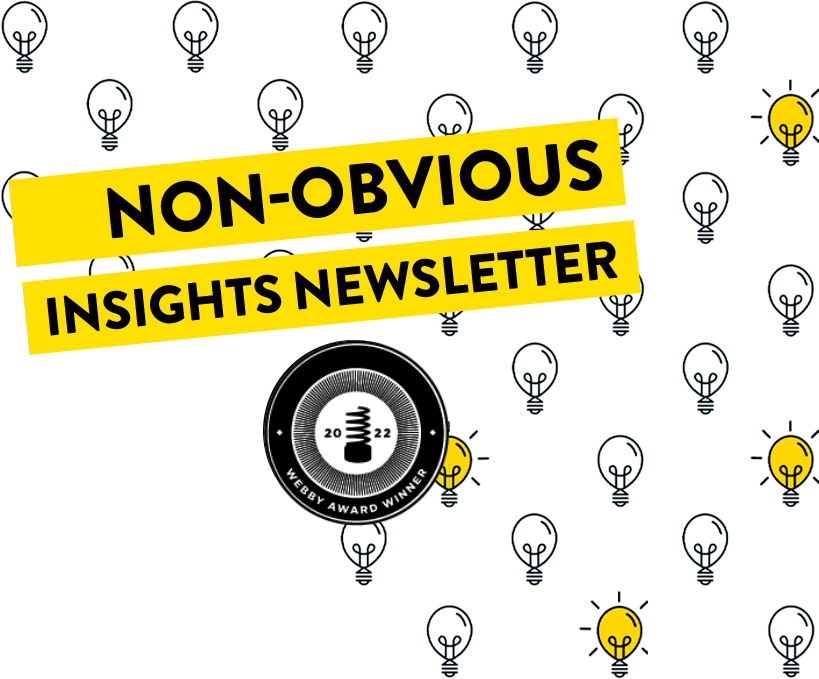Good morning from Las Vegas! I’m finishing up a quick visit here for an event and looking out my window at the new Sphere venue as I collect articles to share with all of you. After last week’s retail picks, it’s nice to get back to sharing some actual stories.
This week, you’ll read about some of the biggest tech innovations announced by both Fast Company and CES, the latest unusual nostalgic marketing effort from Microsoft, the multiple theories for why so many ancient statues are missing noses, who were the real winners and losers from Hollywood’s strikes, how citizen surveillance might be killing San Francisco and how sports journalism looks to be ground zero for the AI-generation battle in media.
Enjoy the stories this week and stay non-obvious,
How Sports Journalism Is the New Battleground for AI
Drew Ortiz and Sora Tanaka have two things in common. The first is that they are prolific fun-loving sports writers for the online version of Sports Illustrated magazine. Tanaka’s bio features a fit young Asian woman who “loves to try different foods” while Ortiz enjoys spending weekends “back on his parents’ farm.” The second is that they are both completely made up, with profile photos purchased from a site that sells AI-generated headshots.
In a recent investigation, the profiles were discovered to be fake and linked back to the magazine’s publisher The Arena Group, which has seemingly offered bylines to similarly fake writer profiles on other properties they own for AI-generated articles. Earlier this week, there was also the revelation that at least one sideline reporter at NFL games would completely make up quotes from a head coach who skipped doing an obligatory half-time interview.
Both have sent the sports journalism world into a tailspin this week, and inspired others across media to openly wonder whether the often boring and formulaic world of sports writing will be the first domino to fall in the quest to generate passable AI content that can replace the need for the lowest rung on entry-level journalism. Why should sports publications be hiring real journalists when stories can be easily made up or fabricated with hardly anyone noticing?
Microsoft Turns the “World’s Most Viewed Picture” into an Ugly Holiday Sweater
“It looks good on a monitor, but better on you.” That’s the legendary tagline for this soon-to-be iconic ugly holiday sweater featuring the “world’s most viewed picture,” that green and blue landscape that has shipped as the default screensaver on Microsoft Windows for nearly a quarter century. This is the perfect combination of nostalgia, dorkiness and understated cultural commentary.
In other words, likely to be a bestseller. More broadly, as a marketing tactic there is an insight here; what if you focused on the one thing that is most recognizable about your brand, even if it’s widely ignored or ridiculed? Microsoft has done this before, with the resurgence of Clippy, and now once again with this inspired sweater design. Someone in Microsoft’s marketing team is either playing a brilliant strategic long game, or running out of new ideas. Or maybe a little of both.
Fast Company and CES Both Announce Their Best Innovations of the Year
From a cordless television that vacuum suctions to your wall to an autonomous weed pulling robot, this year’s selections for Fast Company’s 2023 Next Big Things In Tech list will get you thinking about the future in new and unusual ways. Here’s a spotlight of a few of their most non-obvious choices:
- Klarity – An AI tool that allows you to “talk to contracts” and seek out specific clauses, make or suggest edits and then update the corresponding fields in corresponding backend systems. While it’s not sexy, any tool that can help reduce red tape and make these everyday sorts of challenges easier would be a welcome addition.
- Mill – Food waste continues to be a major problem, but this startup has created a unique service that allows customers to fill up a home bin with food scraps which will then be dehydrated and then reused as chicken feed. It’s a great circular model.
- Pindrop – As more fake content abounds, tools like Pindrop will be more necessary. This one helps detect synthetically generated speech, morphed voices and audiovisual deepfakes.
Also this week, CTA just announced their CES 2024 Innovation Award Winners (full disclosure: I was part of the judging panel this year for this), get ready for what will probably be a weekly roundup of “best of the year” style posts in the coming weeks of December.
Who Won the Hollywood Strikes and What Does It Tell Us?
By now, the fact that much of Hollywood was on strike is probably an afterthought to most of us. Given the backlog of shows and wide range of content readily available for streaming, it’s likely many of us never even noticed anyone was on strike. Even during the pickets, there was always something to watch. Now that it’s over, the temptation is to reduce the whole thing down to the conclusion that it’s simply over. But what actually happened?
In this piece from the Hollywood Reporter, you can get some inside context about who were the winners and losers of the negotiation and how things actually came out. One big win came for up-and-coming writers as their demand to be on set to learn about show production and gain valuable experience to later become showrunners was accepted. Actors will receive a residuals bonus on high performing streaming shows. To spread the bonus, 75% of these will be paid to actors and the remainder will be put into a fund to be allocated to actors on less popular shows.
On the topic of use of AI generated background actors, the results are more mixed and will take time to play out. The Actors Guild is claiming an “unprecedented” victory, but some actors are already warning of loopholes in the agreement that still allow for studios’ widespread use of AI-generated extras instead of hiring actors for those roles.
How Citizen Surveillance Might Be Killing San Francisco
There was a time when I would travel to San Francisco every week for a client meeting. During that moment of my career, I felt so close to the city and the people there that I attended the team holiday party for our SF office rather than the one for my “home” office in Washington DC. I haven’t had reason to be back in the city for more than a year. In that time, I’ve been hearing plenty of stories about it. How the city is worse, crime is higher and some spots are unrecognizable.
How much of the stories are true and how much exaggerated? An article I read this week suggests that part of the city’s problem might be the rampant “citizen surveillance” happening on the streets that allows the city to share every negative interaction instantly via the web. And there is a temptation to share the negative ones, because they predictably get so much engagement.
So, the tech makes it easy to make disturbing portrayals of the city go viral, and the reputation of the city suffers. Is it really as bad as those videos make it seem? Or do we just need more people to share positive footage to balance it all out?
The Mystery of Why So Many Ancient Statues Have Broken Noses
Historical images are filled of statues with broken noses from all cultures. There are many theories to explain this. Ancient Egyptians thought that a life force would enter statues through the nose, so breaking the nose from a statue would (in theory) render it useless. Destroying artifacts has long been used by conquerors to cripple a culture in order to overtake it. Damaging the likeness of a past leader was also a frequent tactic used by new leaders to elevate themselves.
There is, also, the unromantic theory that perhaps so many statues are missing noses because it’s an extremity and therefore likely to fall off by itself over time. All this debate, though, offers an entertaining conclusion about history and perhaps some instruction on how we might look at the world today.
Noticing a pattern and then following your curiosity about it is a hallmark habit of non-obvious thinkers. That same impulse which can lead you down an olfactory rabbit hole can also inspire your biggest new idea. In other words, chasing the answer to a seemingly insignificant question may not entirely be a waste of time.
Even More Non-Obvious Stories …
Every week I always curate more stories than I’m able to explore in detail. Instead of skipping those stories, I started to share them in this section so you can skim the headlines and click on any that spark your interest:
- How a Maine Businessman Made the AR-15 Into America’s Best-Selling Rifle
- Royal Carribean Announces Some People’s Idea of a Nightmare; A Cruise Ship That Holds 10,000 Passengers
- Americans Love Avocados. It’s Killing Mexico’s Forests
- At Lululemon, Being Black Is “Off Brand”
- The U.S. Government UFO Cover Up Is Real — But It’s Not What You Think
- Gaelic Scrabble Launched To Help Keep Declining Language Alive In Scotland
How are these stories curated?
Every week I spend hours going through hundreds of stories in order to curate this email. Looking for a speaker to inspire your team to become non-obvious thinkers through a keynote or workshop? Watch my new 2023 speaking reel on YouTube >>
This Non-Obvious Insights Newsletter is curated by Rohit Bhargava.
Copyright © 2023 Non-Obvious, All rights reserved.
Get this newsletter directly in your inbox every Thursday! Subscribe here >>





